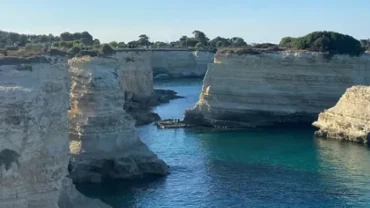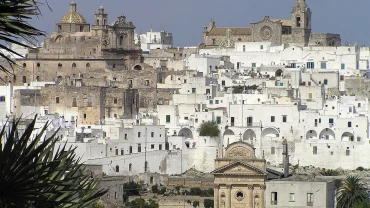A complex of underground cavities of karst origin discovered in 1938
The Castellana Caves, a complex of underground cavities of karst origin Discovered in 1938, of considerable tourist interest, among the most beautiful and spectacular in Italy, are located in the municipality of Castellana-Grotte, about 1.5 km from the town.
Extensive and very steep for about 3 kilometers, they open at 330 m above sea level and less than 500 meters from the town of Castellana. The entire municipal area is characterized by limestone rocks composed mainly of calcium carbonate, mainly of the Altamura limestone type.
The natural entrance to the caves is a huge sixty-meter deep chasm called the Grave. The public tour winds along a scenery for about 1 km. The longest route, it takes two hours and runs for 3 km, among caves and chasms that have been given mythological or fantastic names. From the Grave to the Black or Capitoline She-Wolf Cave, after passing the Monument Cave, passing the Sock and then the Owl Cave, crossing the Snake Corridor, the Precipice Cave and the Little Paradise, one runs through the long Desert Corridor also known as the Underground Grand Canyon (reddish in color due to the presence of iron ore in that section) one reaches the Tower of Pisa Cavern, the clear Pond of Dripping Water, the Red Corridor, the Dome Cavern and finally passing by the shimmering Pond of Crystals, one reaches the White Cave, a bright and shining cavity. The deep chasms that are encountered numerous along the way indicate, finally, the routes through which the watercourse that carved out the caves embarked on its quest for its ultimate goal, reaching sea level. At the end of the underground route and about one thousand five hundred meters from the Grave, a small portal carved into an imposing alabaster wall leads into the last and most beautiful cave of the Castellana Caves: the Grotta Bianca.
A convenient elevator will take you to la Grave, the large 60 m deep cavern with the colossal Cyclops stalagmite group. It is the only room naturally connected to the outside through a skylight that opens in the vault. It gives striking plays of light to the sinkhole at different times of the day. Located at the gateway to the Valle d’Itria, a few kilometers from enchanting villages such as Alberobello, Cisternino, and Polignano a Mare, the Castellana Caves open in the southeastern Murge at 330 m above sea level on the limestone plateau formed in the Upper Cretaceous, about ninety to one hundred million years ago.
The beauty of the Castellana Caves attracts visitors from all over the world, and since the day they opened to the public, more than 15 million people have walked its underground passageways. The visit to the Caves is along a 3-kilometer route: an extraordinary guided excursion, about 70 meters deep, in an amazing scenery, where caves with fantastic names, canyons, deep chasms, fossils, stalactites, stalagmites, concretions with incredible shapes and surprising colors stimulate the imagination of children and adults. They can also be visited by those with various disabilities, so that the amazing hypogeal formation can be appreciated with all sensory emotions.Located at the gateway to the Itria Valley, a few kilometers from enchanting villages such as Alberobello, Cisternino, and Polignano a Mare, the Castellana Caves open in the southeastern Murge at 330 m above sea level on the limestone plateau formed in the Upper Cretaceous, about ninety to one hundred million years ago.
The Grottoes of Castellana are, therefore, in their own right, an unmissable opportunity to admire one of the most amazing natural places in a wonderful Puglia.They can also be visited by those with various disabilities, so that the amazing hypogean formation can be appreciated with all the sensory emotions.Located at the gateway to the Valle d’Itria, a few kilometers from enchanting villages such as Alberobello, Cisternino, and Polignano a Mare, the Castellana Caves open in the southeastern Murge at 330 meters above sea level on the limestone plateau formed in the Upper Cretaceous, about ninety to one hundred million years ago.






Comment (0)